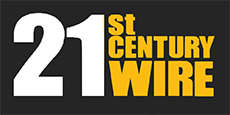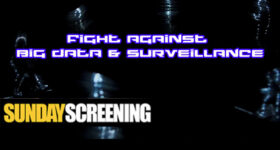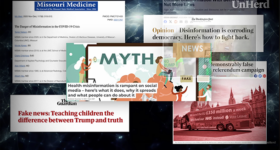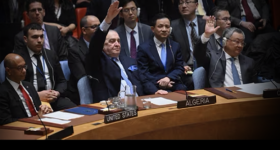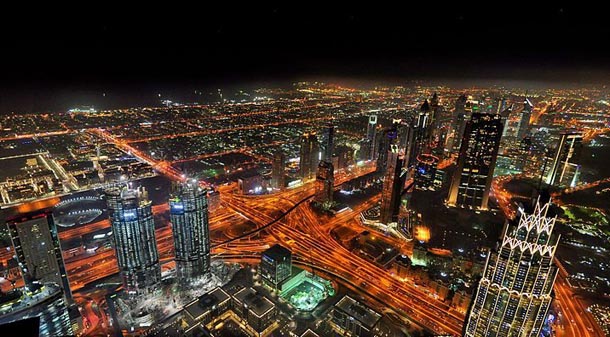
Roads and transportation are a major subject of sustainable development and smart cities (Photo: Challiyan. Source: Wikicommons)
Miles Elliott
21st Century Wire
The Mayor of London, Sadiq Khan, has published a transport strategy that outlines his vision of the future of transportation in Britain’s capital. The strategy conforms to his pledge to be London’s “greenest mayor” as it will reduce motor vehicle traffic while simultaneously encouraging walking and cycling. As a way to discourage motor vehicle journeys, Khan plans to charge drivers a distance-based fee for using city roads. While the scheme is likely to represent an important new revenue stream for the city (or the firm that wins the contract), the plan also seems to resemble parts of the global elite’s technocratic agenda.
First of all, London’s proposal is not the only one of its kind. Various forms of road charging are in use in countries around the world, with many more proposed; the type that charges motorists based on the distance they drive is often called a ‘vehicle miles traveled tax’ (VMT tax). This type of scheme has so far been implemented in Germany, Austria, Slovakia, the Czech Republic, Poland, Hungary and Switzerland, as well as in several locations around the United States, such as Oregon with its OReGO program. Other similar schemes are being tested in countless locations internationally. Numerous think tanks and governments – including the UN and EU – have been urging the adoption of VMT taxes for some time, in what is clearly a coordinated international push.
An obvious problem with this idea is that charging for road use according to distance driven will discriminate against lower-income people and small business, but favour wealthier individuals and larger corporations. When Khan says, “we have to make not using your car the affordable, safest and most convenient option”, he is clearly saying that using a car would become less affordable under the scheme. This broadly fits with the UN’s Agenda 21 plan, which aims to reduce the use of motor vehicles by the general public – as we shall see.
What Khan does not say is that the new policy would be used to raise revenue for London at drivers’ expense, which is not likely to be popular. As the BBC stated, “politicians don’t usually like talking about road charging.” Nevertheless, the revenue generated by the scheme is likely to be a powerful factor motivating Mayor Khan to attempt to introduce it. According to a study by the Policy Exchange, tax revenues from fuel duty could fall by as much as £170 billion by 2030 due to the ‘decarbonisation’ of transportation, largely as a result of the growing number of electric vehicles in use. With such a huge amount of money at stake, politicians are likely to try to make up for it in some way, either through the introduction of VMT taxes, new toll roads or a combination of the two.
Drivers already have an incentive to drive electric or low-emissions hybrid vehicles as these are exempt from road tax in the UK; within London, drivers have an even greater incentive to go electric, as these vehicles are also exempt from central London’s congestion charge. Fuel duty makes a very sizeable contribution to Britain’s treasury, and it has been reported in the past that British fuel tax is higher than that of any other country in Europe.
A further problematic aspect of distance-based road charging is that it will contribute to the ongoing erosion of our privacy. Many of the schemes rely on GPS trackers to calculate distance, and therefore track not only the distance driven but also the location of the vehicle. When combined with all the other forms of surveillance and tracking we are subjected to, will there be any privacy left?
Smart Cities & the Internet of Things
The issues surrounding Mayor Khan’s proposal go much deeper than its immediate economic effects or its effect on privacy, however. His transport strategy is almost certainly just one piece of a larger plan – to transform London into a smart city through the use of technologies such as the Internet of Things (IoT).
The internet is expanding from your desktop, tablet and phone into devices all around us, such as our dishwashers, fridges, televisions and whatever other devices and appliances you can imagine. Thanks to Bilderberger and former CIA Director David Petraeus, we already know that spy agencies plan to capitalize on the flood of data these devices will make available. According to Wired magazine, Petraeus told a conference for In-Q-Tel, the CIA’s venture capital arm, that IoT technologies would be “transformational…. particularly to their effect on clandestine tradecraft.” He went on to say:
“Items of interest will be located, identified, monitored, and remotely controlled through technologies such as radio-frequency identification, sensor networks, tiny embedded servers, and energy harvesters – all connected to the next-generation internet using abundant, low-cost, and high-power computing.”
Now take that idea and apply it to an entire city the size of London. The central idea of a smart city (similar to the ‘smart grid’ for electrical power) is to use information and communications technologies – especially IoT – to enable the city to collect, communicate and process data from all of its assets, with a view to better managing the city. This covers roads and transportation systems, buildings and land, hospitals and health services, water and energy infrastructure, waste management systems, law enforcement, and so on. Smart cities provide city managers an unprecedented amount of data about what is happening at every node of the grid, and therefore much greater control over the city.
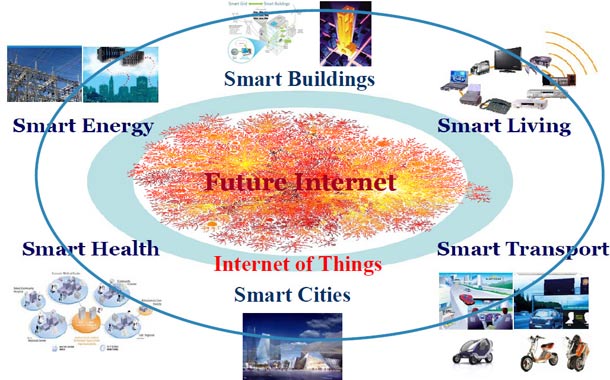
Visual representation of IoT and the smart grid (Image: Ameer Nasrallah. Source: Wikicommons)
Mayor Khan’s road-charging proposal will likely be just one piece of this, perhaps with smart roads and smart cars that can detect one another, calculate distance driven, track vehicle location, probably identify the car and maybe the driver. And that’s just the roads. Imagine such a smart grid applied to all the other elements that make up the city’s many physical assets and systems.
Technocracy: The Big Picture
Just as Mayor Khan’s transport strategy is part of a larger agenda, so too smart cities and IoT are part of a bigger plan – that of the global management class and its drive towards technocracy and scientific dictatorship.
Simply defined, the word ‘technocracy’ means ‘rule by experts’, and is therefore exclusive of other forms of governance, including democracy (rule by the people). The original technocracy movement of the 1920s and 30s envisioned a completely new economic model, one which replaced monetary or price-based transactions with an energy- or resource-based model. One can see how per-mile road charging roughly embodies this idea, as the further one drives, the more energy and resources are consumed.
Although the original technocracy movement was popular for a time, it was overshadowed by Roosevelt’s New Deal. In recent decades, however, there has been a resurgence of similar but more advanced technocratic ideas, to the point where modern technocracy is in danger of taking over virtually every aspect of our lives – albeit often under other names. Technocracy implies totalitarian, scientific control of society, and as such technocratic ideas encompass everything from the blanket surveillance of society and the collection of massive amounts of data on all human activity, even to such things as control of the weather, or the mass deployment of techniques for controlling human behavior.
Patrick Wood, author of Technocracy Rising, traces the rise of the modern technocracy movement to the founding of the Trilateral Commission, established in the 1970s by David Rockefeller and Zbigniew Brzezinski (both recently deceased). In 1970 Brzezinski published the book Between Two Ages: America’s Role in the Technetronic Era. It is believed that this book is what caught the attention of David Rockefeller, and led him to make Brzezinski a leading strategist in the Rockefeller machine. The book was largely concerned with the effects that rapidly-advancing technology would have on society; Brzezinski predicted the dawn of a new age which he called the ‘technetronic era’.
The truth is that the word ‘technetronic’ is virtually interchangeable with the word ‘technocratic’. As Wood put it, “throughout his book, Brzezinski was floating the party line of technocracy”. Brzezinski wrote:
“In the technetronic society scientific and technical knowledge, in addition to enhancing production capabilities, quickly spills over to affect almost all aspects of life directly. Accordingly, both the growing capacity for the instant calculation of the most complex interactions and the increasing availability of biochemical means of human control augment the potential scope of consciously chosen direction, and thereby also the pressures to direct, to choose, and to change.” (pp.9-10)
And later in the book:
“Another threat… confronts liberal democracy. More directly linked to the impact of technology, it involves the gradual appearance of a more controlled and directed society. Such a society would be dominated by an elite whose claim to political power would rest on allegedly superior scientific know-how. Unhindered by the restraints of traditional liberal values, this elite would not hesitate to achieve its political ends by using the latest modern techniques for influencing public behavior and keeping society under close surveillance and control.” (pp.252-253)
In other words, Brzezinski believed that scientific and technological advancement (as well as the resulting scientism that would infect public opinion) held the key to a new, never-before-seen level of control over human behaviour and human society – control which extended not only to complex interactions between individuals but also into human biology itself. In view of emerging technologies such as biometrics and facial recognition; DNA screening and editing; RFID and chip implantation technology; new frontiers within the human brain, including not only psychiatric drugs but now also memory erasure and implantation – all of which offer an unprecedented level of control over society – Brzezinski’s prediction has proved prescient.
Sustainable Development & UN Agenda 21
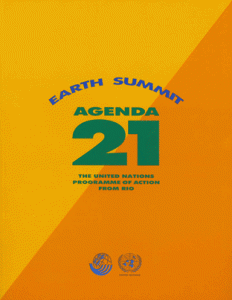 As Brzezinski correctly states, the technocratic elite have no compunction about using any of the tools at their disposal to reach their goal of total control over human society worldwide. A major component of their scientific knowledge concerns human psychology, how people react to various stimuli and events, and how to elicit desired reactions from the public at large. They understand that their task will be much easier if people can be made to willingly accept their agenda, but if the technocrats are honest about what that agenda is, they will likely have very few takers. Therefore they must deceive the public, and one of the ways they do this is to call the technocratic agenda by different names and to claim it exists for other purposes.
As Brzezinski correctly states, the technocratic elite have no compunction about using any of the tools at their disposal to reach their goal of total control over human society worldwide. A major component of their scientific knowledge concerns human psychology, how people react to various stimuli and events, and how to elicit desired reactions from the public at large. They understand that their task will be much easier if people can be made to willingly accept their agenda, but if the technocrats are honest about what that agenda is, they will likely have very few takers. Therefore they must deceive the public, and one of the ways they do this is to call the technocratic agenda by different names and to claim it exists for other purposes.
According to Patrick Wood, technocracy’s newest disguise is sustainable development. Wood makes the case that in the name of sustainable development and combating climate change through the establishment of a ‘green economy’, technocrats are attempting to seize control over the entire global economic system. Moreover, Wood states that the vehicle for injecting sustainable development into the the global economy is UN Agenda 21. In Technocracy Rising, Wood writes:
“Agenda 21 is Technocracy’s plan for the 21st century. The agent of implementation is Sustainable Development. The driver is the United Nations. The perpetrators are members of the Trilateral Commission and their globalist cronies. The victims are all the peoples of the world.” (p.85)
As the name implies, Agenda 21 (now complemented by Agenda 2030) is the UN’s plan for the 21st century; it codifies the concept of sustainable development, entailing: land use restrictions; massive constraints on energy consumption; reductions in water usage; installation of smart meters; increases in the number of city-center dwellings; smaller apartments and living units; and restrictions on travel and transportation, in addition to other measures. As Rosa Koire, author of the original exposé of Agenda 21, Behind the Green Mask: UN Agenda 21, wrote in her book, Agenda 21 is a sweeping plan that will drive people off the land and into cities, where driving a car will be discouraged but having a bicycle will be accepted – just like in future London.
“The push is for people to get off of the land, become more dependent, come into the cities… Out of their private homes and into condos. Out of their private cars and onto their bikes.” (p.16)
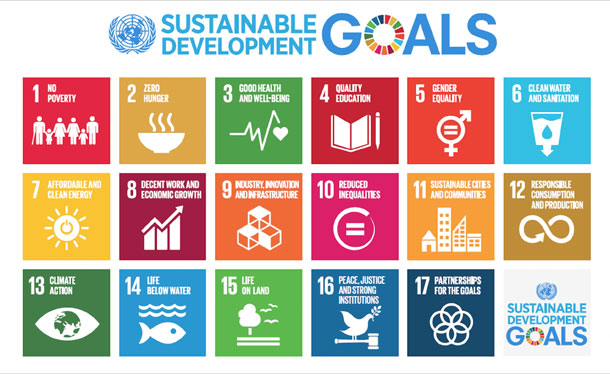
Diagram listing the goals of Agenda 2030, an update to Agenda 21 (Image: United Nations. Source: Wikicommons)
But that is just the beginning. In fact, Agenda 21 is so thoroughly all-encompassing, that Koire describes it this way:
“The plan is a whole life plan. It involves the educational system, the energy market, the transportation system, the governmental system, the health care system, food production, and more. It is a plan to inventory and control all of the natural resources, means of production, and human beings in the world. The plan is to restrict your choices, limit your funds, narrow your freedoms, and take away your voice.” (p.17)
In addition, the sustainable development agenda described in Agenda 21 also has no regard for the general public’s rights or freedoms. Koire writes:
“In a nutshell, the plan calls for governments to take control of all land use and not leave any of the decision making in the hands of private property owners… Individual rights in general are to give way to the needs of communities as determined by a globalist governing body… In anticipation of our objections to such plans, our civil rights will be dissolved.” (p.13)
One wonders how much of the current push to curtail free speech and label dissenters as extremists is related to the sustainable development agenda. Proposals to criminalize global warming denial are at least one example.
Hidden Origins
Both Wood and Koire trace the origins of sustainable development back to the 1992 UN Earth Summit in Rio de Janeiro – chaired by Canadian billionaire, Rockefeller crony, and former Secretary-General of the UN Conference on Environment and Development (UNCED), Maurice Strong. It was this summit that gave birth to the original Agenda 21 document. However if we go back just one more year, to 1991, we find the following quote from the book The First Global Revolution: A Report by the Council of the Club of Rome.
“The common enemy of humanity is man. In searching for a new enemy against whom we can unite, we came up with the idea that pollution, the threat of global warming, water shortages, famine and the like, would fit the bill… All these dangers are caused by human intervention, and it is only through changed attitudes and behaviour that they can be overcome. The real enemy then is humanity itself.” (p.75)
The Club of Rome, a globalist think-tank with direct access to the highest levels of the UN, clearly states that they were looking for an enemy to unite against. Only then did they come up with the idea that sustainability was suited to the task; sustainable development and Agenda 21 were born and adopted by the UN the following year. It is interesting to note that the origins of the Club of Rome, like those of the UN itself, as well as Zbigniew Brzezinski and Maurice Strong, are intimately connected to the Rockefeller family.
It is clear that the concept of sustainable development, which necessitates total surveillance and control, and out of which we get the concept of smart cities which relies on IoT, is at least in part a trick played by the technocratic elite to allow them to enact their technocratic plans without the general public ever being fully aware of what is happening. As Koire says:
“Propaganda infuses our culture with messages that there are just a few winners and many losers; that we are killing the earth and time is running out; that prosperity is an anachronism and detrimental to life; that individual freedom is selfish and injures those who are less free. These messages are crafted to shame and pressure you, and to create a sense of urgency that impairs your ability to reason clearly.”
Wood describes the trick this way:
“Sustainable Development is a Trojan horse that looks good on the outside but is filled with highly toxic and militant policies on the inside. It promises a utopian dream that it cannot possibly deliver. There is no economic growth if living standards and consumption patterns regress back into the 1800s, or if population is curtailed. There is no economic satisfaction if people cannot easily enjoy and transfer real property or accumulate wealth and savings. There is no personal satisfaction if people are constantly under a microscope for analysis of their sustainable development activity, or the lack of it.”
Furthermore, Koire points out that the Agenda 21 plans are not openly provided to national policymakers to be debated and filtered through normal democratic channels. Instead they are the subject of an end-run around the democratic process by being given directly to municipal and local bodies to implement as if the ideas were local initiatives. Koire identifies the body known as ICLEI – the International Council for Local Environmental Initiatives – as the conduit for influencing local governments to adopt the UN plans. It is worth noting that even before he was mayor, Sadiq Khan committed to making London a full member of ICLEI.
The transformation of cities according to a global master plan, including aspects such as promoting cycling and discouraging car use, is explicitly included in documents such as Agenda 21 and the New Urban Agenda adopted by the UN. Is it a coincidence that the new model for road charging – VMT taxes such as the one proposed for London – is simultaneously appearing in the local schemes of numerous cities and countries around the world?
Broken Promises: Benefits Heavily Touted, Threats Never Mentioned
As these programs are imagined, developed and rolled out, they are always presented to the public as being for our benefit, capable of achieving wonderful things. Some of the selling points of smart cities include better capabilities for fighting crime, fostering economic growth, managing the effects of climate change, and improving the delivery of services, among many others. For instance, Mayor Khan’s proposed changes to road use are couched in ‘green’ terms of improving air quality, reducing emissions, etc. (Khan is also on record claiming “I want London to be the greenest city in the world. I want to be the greenest mayor London’s ever had.”)
While those things could result from the scheme, when this piece of the technocratic plan is combined with other smart-city technologies, city managers will possess immense power over the entire population of the city. Most obviously, London’s scheme will likely result in fewer people using and owning their own cars – explicitly stated as a goal of the scheme; however, Mayor Khan will never say that this represents a de facto reduction of the public’s level of personal mobility and freedom to travel, which is another effect it will have.
At a certain point, people must begin to think that we’ve heard all this before…
Nuclear energy was supposed to result in unlimited energy, “too cheap to meter”; instead we got environmental disasters like Fukushima (the effects of which will linger for thousands of years), a nuclear waste problem with no solution, smart meters that pose a danger to health and security, and energy bills that only seem to rise.
Intellectuals of the 1960s and 70s promised that the coming computer age would be an age of leisure; instead, we are surrounded by computers, but most of us are overworked and underpaid. (When we enter the age of robots and AI, on the other hand, the future will not need us.)
The advent of petrochemicals promised “a marvelous catalogue of useful materials: cloth with the sheen of silk or the fuzziness of wool; cables stronger than steel; synthetics with the elasticity of rubber, the flexibility of leather, the lightness of paper, or the workableness of wood; detergents that wash as well as soap without curdling in hard water; chemicals that can kill dandelions, but not grass; repel mosquitoes, but not people; diminish sniffles, reduce blood pressure, or cure tuberculosis.” Now that all sounds wonderful. What wasn’t mentioned is that many of these materials are toxic and cause cancer, but are not biodegradable and therefore will linger in the environment for decades, if not centuries.
Sustainable development, while appealing to noble ideals, is almost certainly another example of a major social change of which the threats are whitewashed while the potential benefits are widely advertised and oversold. Mayor Khan’s latest proposal is but one small example of this.
More on this story from Evening Standard…

Traffic at an intersection in the City of London (Photo: mattbuck. Source: Wikicommons)
Pippa Crerar
Evening Standard
Motorists could face steep new charges to drive into central London by 2025 under radical plans to clean up the capital’s air announced by Sadiq Khan today.
The Mayor’s transport strategy indicated petrol and diesel drivers would pay substantially more than the £24 ultra-low emissions levy that comes into force in spring 2019.
Hybrid and electric vehicles would face the lowest charges if intelligent road-user pricing is introduced.
At the same time, the boroughs will be encouraged to roll out local charging schemes in town centres across the capital such as Croydon and Enfield.
Continue reading this story at Evening Standard
READ MORE TECHNOCRACY NEWS AT: 21st Century Wire TECHNOCRACY Files
SUPPORT OUR WORK BY SUBSCRIBING & BECOMING A MEMBER @21WIRE.TV
